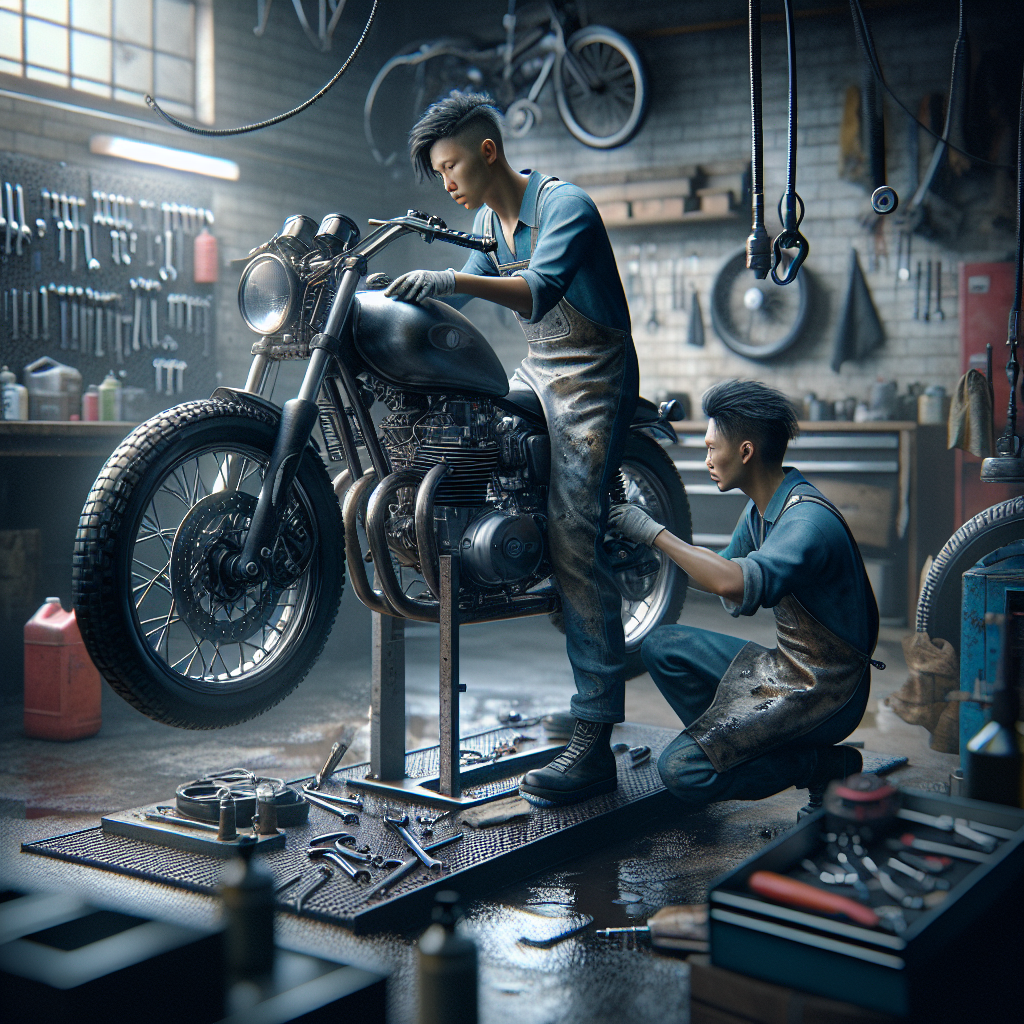Motorcycle Safety, Motorcycle & Rider's Care, Motorcycle Servicing
The Fascinating Journey of Motorcycle Parts: From Vintage Charm to Modern Marvel
Motorcycle parts in Singapore have transcended simple utility to become emblems of technological advancement and design prowess. As the local biking culture thrives, enthusiasts have access to a plethora of components that blend historical craftsmanship with contemporary innovation. From sleek, aerodynamic frames to robust, high-performance engines, each component has been refined to enhance the rider’s experience.
In Singapore, where both urban commuting and scenic rides are popular, the evolution of motorcycle parts such as chassis, brake pads, and tyres has not only improved the aesthetic appeal of motorcycles but has crucially enhanced safety and efficiency. The market’s responsiveness to evolving rider needs and environmental considerations ensures that Singapore remains at the forefront of motorcycle technology, providing bikers with parts that are not only about heritage and high performance but also about embracing the future of mobility.
It’s an exciting time to be a motorcycle enthusiast. Whether you’re an ardent fan of the gleaming beauties gracing the open roads today or a vintage bike aficionado, appreciating the hum of an old engine comes naturally to you. This post will take you on a riveting journey, tracing the evolution of motorbike parts from vintage charm to the engineered marvels powering the bikes you see today. We’ll explore the chassis, frame, brake pads, tyres, wheels, and engine, giving you a closer look at the intricate transformation cycle these parts have undergone.
Motorcycle Parts Chassis: The Backbone of Change
In the pioneering phases of motorbike manufacturing, the chassis merely existed as a straightforward, robust structure, often shaped from welded steel. Its primary function was to provide support. However, with the advent of technology, this changed. Modern bike frames are feathers in the cap of engineering marvels. Aluminium and even carbon fibre chassis have taken the center stage, reducing weight drastically while amping up the structural integrity.
Such innovation helped the bikes to streamline their form, increasing their speed and agility. Furthermore, these materials are resistant to climatic changes, rendering them more durable. The visible evolution of the chassis from a purely functional design to a sophisticated, performance-enhancing marvel has not only met the aesthetic desire of modern bikers but also their demand for high-performing machines as they have variations of motorcycle type.
The Frame: Safety and Style
The frame of a motorbike works much like the skeletal system does for a human. It is the structure upon which all else is mounted. In the past, these frames were wooden. However, as bikes gained popularity, the need for a more robust material arose, leading to the employment of steel. As technology advanced and safety became paramount, metal frames transitioned into alloys and carbon fibres: materials that are lighter yet stronger. This remarkable leap assured superior rider safety, as these materials absorb impact better, reducing the risk of injuries. Simultaneously, they gave the bikes a sleeker profile. The evolution of frames transformed the motorcycles from mere workhorses to elegantly crafted, efficient machines.
Brake pads and Tyres: The Art of Halting
The importance of braking was understood early in the motorbike’s development. Vintage models employed mechanical drum brakes, which provided adequate stopping power considering the speeds those bikes would reach. But, as engines evolved to become more powerful, enabling higher speeds, so did the need for more accurate stopping mechanism. Hydraulic disc brakes became the go-to for stopping quick and safe.
On another hand, the much-needed road traction has been transformed with the development of innovative tread designs and softer compounds from the basic, hard-rubber tyres. These innovations enhance grip on the road, reducing the chances of skidding. Hence, the evolution of brake pads and tyres not only assure the art of halting but also personify the blend of technology and safety.
Wheels: A Revolving Transformation
The wheel has perhaps seen one of the most drastic transformations. Once, they were fully wooden. As the need for durability and better performance surged with the wave of technology, metal rims and alloy wheels replaced the wooden predecessors. The introduction of lighter, stronger materials and technological advancements are greatly responsible for the modern wheels. They are robust enough to handle various road conditions yet light enough to guarantee ease of manoeuvrability. This transformation of wheels has made the connection between biker and road smoother and safer.
Engine Evolution: From Simple Machines to Powerhouses
Arguably, the evolution of engines in motorcycles is the most evident change. The age-old simple one-cylinder engines have paved the way for cutting-edge V-twin and inline four-cylinder powerhouses. This evolution is no less than phenomenal. Today’s bikes are no longer mere vehicles; they are beasts known for their speed, power, and performance. Engine enhancements have enabled higher top speeds, better fuel economy, and significantly improved reliability. This is a crucial factor in complementing the modern rider’s needs, keeping in view of the changing environmental norms and efficiency demands.
To Infinity and Beyond: The Continual Evolution of Bikes
Like all technological advancements, the journey of motorcycles from vintage to modern is a testament to human creativity and innovation. The continuous strive for better performance, increased safety, and enhanced aesthetics has triggered a rapid transformation of motorcycle components. Looking forward, we can only expect this evolution to continue—further pushing the boundaries and satisfying our natural longing for speed, style, and sophistication.

Get It Fix!
I know you want the best for your beloved bike? Why settled for 2nd best? Get our world class service technicians to work on your steed. Trust the best!


I love how motorcycle parts in Singapore have evolved to become emblems of technological advancement and design prowess. As a bike enthusiast, I appreciate the attention to detail and innovation that goes into each component.
Hi May, thank you for sharing your enthusiasm towards the evolution of motorcycle parts in Singapore! We’re delighted to hear that our readers appreciate the attention to detail and innovation that goes into each component. At Speed Zone, we take pride in offering a comprehensive range of new and used bikes, as well as our expertise in servicing and customising motorcycles to meet the needs of our customers. If you have any specific queries or would like to know more about our products and services, please feel free to contact us at +65 6225 6225 or email [email protected]. We’d be happy to assist you. Looking forward to serving you in your motorcycle journey!
The article highlights the incredible transformation of motorcycle parts in Singapore. From vintage charm to engineered marvels, it’s amazing to see how technology has improved performance, safety, and aesthetics.
Thank you for sharing your thoughts on the evolution of motorcycle parts in Singapore! We’re thrilled to hear that our article resonated with you. At SpeedZone, we’re committed to providing top-notch motorcycle parts and accessories that meet the needs of riders like yourself. Our team is always excited to learn about the latest advancements in the industry and how they can enhance the riding experience. If you have any specific questions or concerns about our products or services, please don’t hesitate to reach out. We’re here to help! You can contact us at +65 6225 6225 or email us at [email protected]. Looking forward to hearing from you soon!
I’m thrilled to read about the evolution of motorcycle parts in Singapore. The focus on innovation, safety, and style is truly inspiring. Can’t wait to see what’s next!
Dear Rohana Sivaram, we’re thrilled that you’re excited about the evolution of motorcycle parts in Singapore! At Speed Zone, we’re committed to staying ahead of the curve when it comes to innovative technology and design. We’d be happy to help you with any questions or concerns you may have about our motorcycle parts and accessories. Please feel free to contact us at Tel: +65 6225 6225 or Email: [email protected]. We’re always here to assist you. Thanks for your enthusiasm, and we look forward to seeing what’s next in the world of motorcycles!